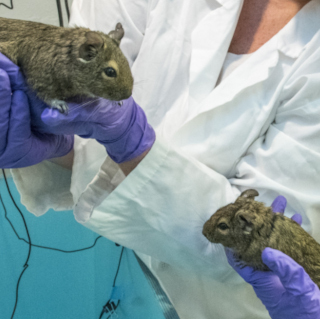TCDD
Last Review Date: September 25, 2020
I. Background
Production. TCDD, a polychlorinated dibenzodioxin (PCDD), enters the environment as a byproduct of industrial processes, such as waste incineration (medical and municipal), paper bleaching, and herbicide production. Additionally, TCDD can enter the environment naturally from forest fires and volcanic eruptions.
Distribution in
Human exposure. This persistent environmental contaminant is found at low levels in the environment, and people are exposed to small amounts of it each day primarily via the diet. In fact, more than 90% of daily dioxin intake is through dairy products, meat, and fish. Levels in the serum and adipose tissue of the general population typically range from 3-7 ppt, with the higher concentrations being found in adipose. Inhalation and dermal exposures are rare.
Toxicity and perceived toxicity to humans/animals. Little is known about the breakdown of TCDD in the human body, but its toxicity has been extensively studied in animals. Many adverse effects, such as reproductive damage and birth defects, chloracne with acute exposure, weight loss, immune suppression, and carcinogenesis, have been reported following exposure; however, these animal studies utilize doses that are 10 to 1000 times the level typically found in people.
II. SDS Information
Structure of TCDD. In its crystalline form, TCDD is colorless to white.
Vehicle to dilute TCDD. First, crystalline TCDD is diluted in anisole at 1mg/ml then further into peanut oil such that the concentration brought into LAR is less than or equal to 1.5 µg/ml TCDD in peanut oil. Peanut oil is not a hazard nor is the amount of anisole present in the solution.
Chemical signature and SARs. In our
Volatility. The vapor pressure of TCDD is 7.4x10-4 mmHg at 25°C, which indicates that this compound is not volatile with such a low vapor pressure. In comparison, the vapor pressure of water at 25°C is 23.756 mmHg. Moreover, upon adsorption to sediment, the volatilization removal half-life is greater than 50 years.
III. ADME
Absorption. In a lipophilic vehicle, such as corn oil, 70-80% of the initial dose is absorbed in orally-exposed rodents. In a human volunteer, >87% of
Disposition. Once absorbed into the bloodstream, TCDD is primarily distributed in adipose tissue with very little in the liver. However, following intratracheal
Metabolism/excretion. TCDD is not readily metabolized, as the half-life is 7-12 years in humans and approximately 8 days in mice. However, within the first 24 hours of administration in mice, about 70% of the administered dose is excreted in feces and about 1-2% of the dose is excreted in urine. Following an intratracheal dose of 0.32µg of TCDD, rats excreted 26.3% in feces in the 3 days following exposure.
IV. Risks
Perceived. Dioxins are reported to be carcinogenic and cause many adverse effects so LAR staff may believe that they are at risk of developing these conditions.
Actual. During TCDD administration, investigators wear gloves so there is no risk of dermal exposure at any time. Moreover, C57Bl/6 mice possess a
As previously mentioned, the background body burden of TCDD in the general population is 1 ng/kg (based on serum levels and average of 22% body fat) and the adverse effects of TCDD may be observed at 31-6600 ng/kg depending on age, gender, health and nutritional
V. Route and Doses Utilized in Shepherd Lab at UM
As previously described, TCDD is dissolved in peanut oil to make a 1.5 µg/ml solution, which is brought down to LAR in a vial. Animals receive 10 µl/g body weight (~250 µl solution) by oral gavage for a delivered dose of 15ug TCDD/kg body weight (~0.375 µg TCDD/mouse). This dose is ~10x less than the LD50 of TCDD, as the LD50 for a mouse is ~120 µg/kg (C57Bl/6 mice), ~ 1mg/kg for hamsters, and not known in people. The following scenario takes into account all of the aforementioned information:
- Following gavage, each of our mice will secrete ~0.2625 µg TCDD in the feces within 24h.
- If someone is somehow exposed to all of the TCDD in a cage, the dose would be 0.0035 µg/kg
VI. Summary of TCDD Procedures in Laboratory Animal Resources at UM
TCDD is a persistent environmental contaminant that we use in our laboratory to study the immunomodulatory effects of aryl hydrocarbon receptor activation. Although TCDD is classified as a carcinogen, we use a very low dose in mice that does not elicit this effect. Moreover, TCDD is not a volatile compound even when excreted so there is no significant risk of dermal or inhalation exposure.
All animals to be treated with TCDD will be housed in SB 028. Although not a requirement (relative to the TCDD exposure) cage changing will be done in the BSL-2 biosafety cabinet located in that room although it is not a requirement. There is no real risk associated with the amount of TCDD that could potentially end up in the tissue or bedding, and the maximum levels that could possibly be in either tissue or bedding are below all regulatory limits so that both tissue and bedding may be disposed of in the normal waste streams.
VII. References
Reports from the following agencies were used to produce this report regarding the toxicity of TCDD:
- Agency for Toxic Substances and Disease Registry (ATSDR)
- Environmental Protection Agency (EPA)
- National Institute for Occupational Safety and Health (NIOSH)
- National Toxicology Program (NTP)
